Aversive Imagery Causes De Novo Fear Conditioning
- PMID: 31150589
- PMCID: PMC6651612
- DOI: 10.1177/0956797619842261
Aversive Imagery Causes De Novo Fear Conditioning
Abstract
In classical fear conditioning, neutral conditioned stimuli that have been paired with aversive physical unconditioned stimuli eventually trigger fear responses. Here, we tested whether aversive mental images systematically paired with a conditioned stimulus also cause de novo fear learning in the absence of any external aversive stimulation. In two experiments (N = 45 and N = 41), participants were first trained to produce aversive, neutral, or no imagery in response to three different visual-imagery cues. In a subsequent imagery-based differential-conditioning paradigm, each of the three cues systematically coterminated with one of three different neutral faces. Although the face that was paired with the aversive-imagery cue was never paired with aversive external stimuli or threat-related instructions, participants rated it as more arousing, unpleasant, and threatening and displayed relative fear bradycardia and fear-potentiated startle. These results could be relevant for the development of fear and related disorders without trauma.
Keywords: aversive conditioning; eyeblink reflex; fear; fear conditioning; imagery; open data, open materials.
Conflict of interest statement
Figures






References
MeSH terms
LinkOut - more resources
Full Text Sources

